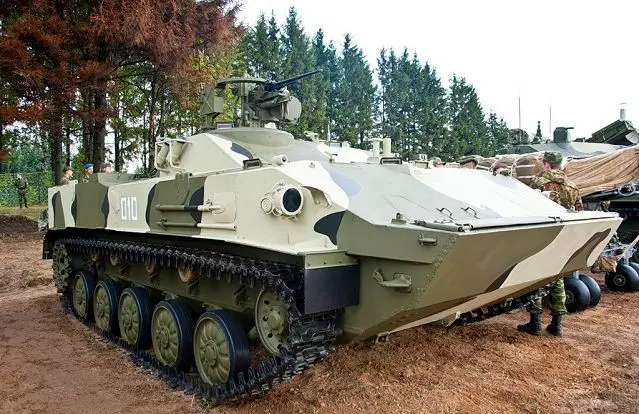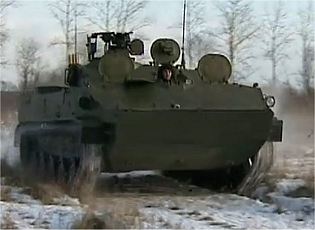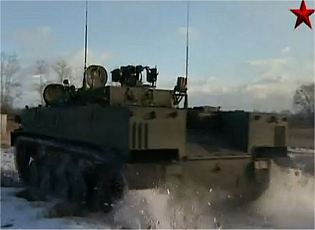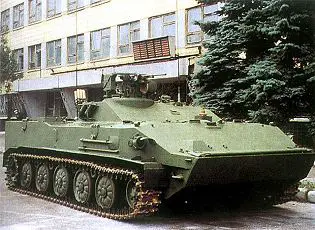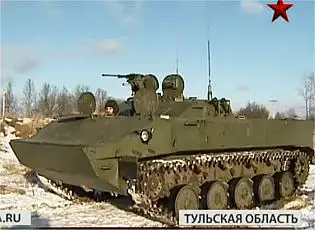The RHM-5 "Povozka D-1" or RKhM-5 was unveiled in December 2011 by the Russian army. The vehicle is designed to be used as NBC reconnaissance armoured vehicle for the airborne troops. In January 2012, the first vehicles were delivered to Russian airborne troops, 106th Airborne Division. It was reported that the production of the RHM-5 began in 2009 by he Russian Company OAO "Zavod Tula". The RHM-5 is a sophisticated instrument complex, mounted on the chassis of the Russian airborne armoured fighting vehicle BMD-3. The use of the BMD-3 chassis is a logical choice to standardize maintenance and crew training, in fact, the BMD-3 is widely used in the Russian airborne troops. The vehicle has the ability to provide radiation, chemical and biological intelligence in complex topography, in all weather and night conditions. He is is equipped with latest technology of NBC-Intelligence systems as different type of nuclear, bacteriologic and chemical device detectors, as well as navigation systems for collecting, processing and transmission by radio or in a global military network. The crew can send information in safety condition against the effects of weapons of mass destruction on the battle field.
|
| Armament |
|
A small turret is located at the right side of the top of the hull which is equipped with a remote weapon station armed with 7.62 mm machine gun. A bank of three smoke grenade dischargers is mouted to each side of the turret. An infrared searchlight is mounted to the left side of the turret.
|
| Design and protection |
|
The RHM-5 "Povozka D-1" (RkHM-5) is based on the hull of the Russian made airborne infantry fighting vehicle. The driver is seated at the front of the vehicle, and has a single-piece hatch cover and three day periscopes for forward observation, the centre one of which can be replaced by a night vision periscope. There is a man seated either side of the driver and each has a single-piece hatch cover and at least one day periscope. As the BMD-3, the hull of the RHM-5 is made in all-welded aluminium wich provide a protection for the crew against small arms fire and shell splinters.
|
| Propulsion |
|
The RHM-5 or RkHM-5 uses the same chassis and powerpack as the BMD-3. The power pack is at the rear of the hull and consists of a 2V-06-02 water-cooled diesel developing 450 hp, which gives a very high power-to-weight ratio of 34 bhp/t. The engine is coupled to a hydromechanical transmission with five forward and five reverse gears and a hydraulic steering unit. As the all family of BMD-3 vehicle, the RHM-5 is fitted with an hydropneumatic suspension which give the possibility to adjust ground clearance between 130 and 530 mm, although for normal road travel it is 450 mm. The suspension either side consists of five rubber-tyred roadwheels, four track-return rollers, drive sprocket at the rear, and idler at the front. The RHM-5 can run at a maximum road speed of 70 km.
|
| Accessories |
|
An infrared searchlight is mounted to the left side of the turret. The RHM-5 is equipped with Glonass satellite position system and sophisticated computer technology. The GLONASS is a Global Navigation Satellite System, radio-based satellite navigation system operated for the Russian government by the Russian Aerospace Defence Forces. The RHM-5 is fully amphibious being propelled in the water at the maximum speed of 10km/h by two water-jets mounted either side at the rear of the vehicle.
|
| |
| Specifications |
| Back to top |
|
Armament
|
|
One 7.62 mm machine gun
|
|
Country users
|
|
Russia
|
|
Designer Country
|
|
Russia
|
|
Accessories
|
|
GLONASS GPS, night vision, NBC protection system, NBC device detectors with computer.
|
|
Crew
|
|
3 + 4 soldiers
|
|
|
Armor
|
|
Protection against small arms ans shell splinters,
|
|
Weight
|
|
? kg
|
|
Speed
|
|
70 km/h maximum road, 10 km/h on water
|
|
Range
|
|
500 km on road
a
|
|
Dimensions
|
|
Length, 6.36 m; Width, 3.13 m; Height, ? m
|
|
|
| |
|
